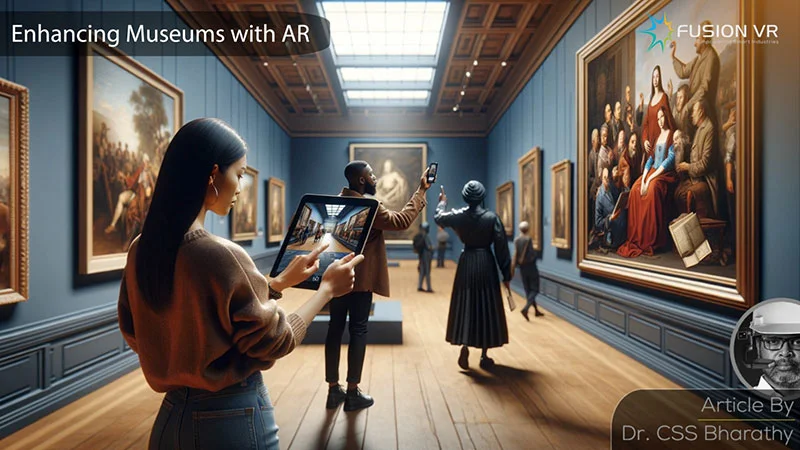Augmented Reality (AR) is revolutionizing the way art and museums engage with audiences by blending the physical and digital worlds. By overlaying digital content onto real-world exhibits, AR enhances the visitor experience, providing interactive storytelling, educational insights, and immersive exploration. This article explores how artists, curators, and museum professionals can harness AR technology to create compelling and enriching experiences for art enthusiasts and cultural explorers alike.
Why Augmented Reality for Art and Museums?
Augmented Reality offers unique advantages for art and museums:
- Enhanced Engagement: AR brings artworks to life with interactive elements, allowing visitors to explore deeper layers of information and context.
- Accessibility: AR can provide accessible information in multiple languages, audio descriptions, and visual enhancements for diverse audiences.
- Interactivity: Visitors can engage with exhibits in new ways, such as virtual tours, interactive storytelling, and gamified experiences.
- Education: AR bridges the gap between education and entertainment, offering learning opportunities in an engaging and memorable format.
Applications of Augmented Reality in Art and Museums
- Interactive Exhibitions
- Virtual Tours: Offer guided or self-guided tours where visitors can explore artworks in-depth with AR overlays providing historical context, artist insights, and multimedia content.
- Digital Replicas: Display digital replicas of fragile or inaccessible artworks, allowing visitors to examine details up close.
- Educational Experiences
- AR Annotations: Overlay annotations or animations on artworks to explain techniques, symbolism, and historical significance.
- Interactive Learning: Gamify learning experiences with quizzes, puzzles, and interactive elements that encourage exploration and discovery.
- Artistic Interpretation
- Artist Experiences: Enable artists to create AR-enhanced artworks that evolve over time or respond to viewer interaction, blurring the line between creator and audience.
- Temporal Experiences: Create AR installations that change based on the time of day, weather conditions, or visitor interaction.
- Enhanced Accessibility
- Multisensory Experiences: Cater to diverse audiences with audio descriptions, sign language interpretation, and tactile feedback integrated into AR experiences.
- Language Options: Provide AR content in multiple languages to accommodate international visitors and non-native speakers.
- Community Engagement
- Crowdsourced Content: Encourage visitor participation by allowing them to contribute stories, interpretations, or artworks to AR exhibits.
- Social Sharing: Facilitate social sharing of AR experiences to extend the museum’s reach and foster community engagement.
How to Create Augmented Reality for Art and Museums
- Define Your Goals
- Identify Objectives: Determine what you want to achieve with AR—whether it’s enhancing visitor engagement, providing educational content, or showcasing innovative artworks.
- Audience Consideration: Understand your target audience and their preferences to tailor AR experiences accordingly.
- Choose AR Tools and Platforms
- Assemblr: Utilize Assemblr’s user-friendly interface to create AR content with drag-and-drop functionality, incorporating 3D models, animations, and interactive elements.
- Unity with Vuforia: For more complex projects, Unity with Vuforia provides robust AR development capabilities, allowing for customized interactions and high-quality visuals.
- ARKit/ARCore: Develop AR applications specifically for iOS (ARKit) or Android (ARCore) platforms, leveraging their native capabilities for seamless AR experiences.
- Create Content
- Select Artworks: Choose artworks or artifacts that will benefit from AR enhancements, considering their historical significance, visual appeal, and educational value.
- Develop AR Enhancements: Design AR overlays, animations, and interactive elements that complement and enrich the visitor’s experience without overshadowing the artwork.
- Integrate and Test
- Implement AR Features: Integrate AR content into the museum or gallery space, ensuring it enhances rather than detracts from the physical exhibits.
- User Testing: Conduct thorough testing on various devices to ensure functionality, usability, and accessibility of AR experiences.
- Launch and Evaluate
- Deployment: Launch AR experiences with clear signage and instructions for visitors to access and interact with the augmented content.
- Feedback and Iteration: Gather visitor feedback to continuously improve AR features, addressing usability issues and enhancing content based on audience response.
Case Studies and Success Stories
- The Museum of Modern Art (MoMA): MoMA’s use of AR has enhanced visitor engagement with AR-guided tours, interactive exhibits, and artist interviews accessible via mobile devices.
- The British Museum: AR applications at the British Museum allow visitors to virtually explore ancient artifacts, reconstruct lost sculptures, and delve into historical contexts.
Conclusion
Augmented Reality is transforming the landscape of art and museums, offering unprecedented opportunities for engagement, education, and creativity. By leveraging AR technology, institutions can enrich visitor experiences, foster deeper connections with artworks, and embrace innovative storytelling techniques. Whether you’re a curator looking to enhance exhibitions or an artist exploring new forms of expression, AR provides a dynamic platform to redefine how art is experienced and appreciated in the digital age. Embrace the potential of Augmented Reality for art and museums, and embark on a journey to create immersive, unforgettable experiences that captivate and inspire audiences worldwide.
